The Most-Used Prompts For AI Videos and Images
People are using AI to create hundreds of thousands of images and videos based on existing characters, places and ideas. But which names and styles are replicated the most? Kapwing trawled through Midjourney to find out.

The arguments around the right to invoke existing artists’ styles in image and video generation are complex, emotionally charged — and still unresolved.
It’s an issue that creatives are beholden to follow closely as we experiment with the new tools and workflows at our fingertips.
“The history of art is the history of people borrowing and adapting techniques and tropes from earlier work,” writes the New York Times Magazine’s Ethicist columnist, Kwame Anthony Appiah. “Copyright protects an image for a period… but it doesn’t seal off the ideas used in its execution.”
“But there’s a difference between general styles and highly distinctive ones that become almost synonymous with someone’s identity,” counter Kai Riemer and Sandra Peter, information technology academics at the University of Sydney. “When an AI can generate work ‘in the style of Greg Rutkowski’ – a Polish artist whose name was reportedly used in over more than 93,000 prompts in AI image generator Stable Diffusion – it potentially threatens both his livelihood and artistic legacy.”
As 2025’s wave of Studio Ghibli-style memes demonstrated, generative AI has the power to realign the whole vibe of an artist or franchise when used en masse. But which other creatives and brands are AI users invoking the most in their prompts? And what do the ‘victims’ think about it?
To find out, Kapwing researched the number of times that 897 popular keywords — from Frank Lloyd Wright to Wes Anderson to Krispy Kreme — have been used in Midjourney prompts.
What We Did
We built a seed list of keywords across eight different categories of prompt style (e.g., artist names) and subject (e.g., media franchises) using the Midlibrary database and manual research. Then, we recorded the number of AI video and image prompts containing these keywords (e.g., “Wes Anderson”) on the Midjourney Discord.
Key Findings
- Art Nouveau poster designer, Alphonse Mucha is the most-used artist appearing in 230,794 Midjourney prompts.
- Digital artist, WLOP is the most prompted Illustrator, appearing in 166,415 Midjourney images and Videos.
- Wes Anderson has been used in 92,378 Midjourney prompts, making him the most-prompted movie director.
- The most-used architect is Zaha Hadid, who has appeared in 63,103 prompts.
- New York is the most prompted city on Midjourney with 156,598 video or images.
- Star Wars (160,495) and Akira (53,333) are the most-used franchise and anime, respectively.
- McDonald’s (18,318) has been used in twice as many prompts as any other fast-food chain.
The Most-Prompted Fine Artist is Alphonse Mucha

A digital image may not convey the same texture, handcraft and “aura” of seeing a painting or sculpture for real, but the names of history’s greatest artists have become synonymous with particular feelings and effects. Pairing a fine artist’s style with a new visual idea can convey your message to audiences in a familiar language.
The Czech painter and graphic designer Alphonse Mucha is the fine artist that Midjourney users invoke the most, with 230,794 prompts featuring his name. Mucha has become synonymous with sensual, figurative Art Nouveau imagery, and designed many of his best-known works specifically to grab the public’s fleeting attention in the ever-hastening social realm.
Plus, Mucha’s work is in the public domain — although this hardly sets him apart from Rembrandt, Da Vinci or Gustav Klimt (who was Mucha’s contemporary), each of whom appears in far fewer prompts than Mucha.
Fantasy Illustrators WLOP and Greg Rutkowski Among Most Copied
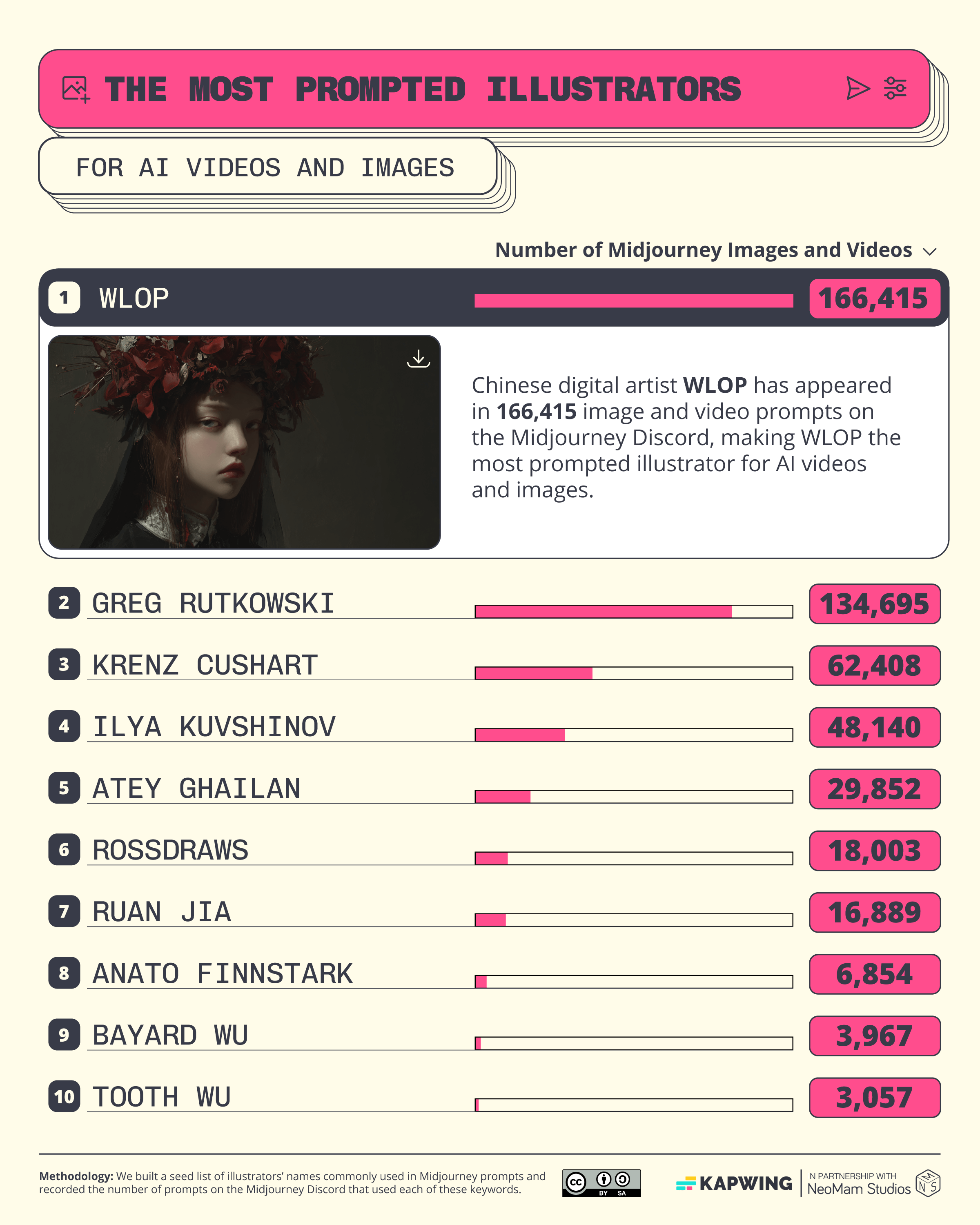
Digital fantasy artist Greg Rutkowski is the second most-used illustrator on Midjourney with 134,695 prompts in his name. He is also involved in a class-action lawsuit against Midjourney, DeviantArt and Stability.
“I'm shocked and anxious actually, because what is happening right now will affect not just me but also many other artists and their future,” says Rutkowski. “Someone can create something in a matter of five seconds using my name, or any other artist's name, as a prompt, as a guideline for style… the terrifying thing is that it's really hard to see the future for ourselves.”
Illustrators are on the front line of the economic battle between generative and handmade imaging, not least because original illustrations are often seen as a luxury to be cut down on when times are hard for publishers.
In some cases, illustrators may bridge the gap by using AI to speed their workflow. “I also use A.I. to delete unwanted elements from photos, extend missing backgrounds and boost resolution. I’m sure I will find many more applications in the future,” writes illustrator Christoph Niemann in a thought-provoking piece for the New York Times. Still, he notes, the “essence of art… is that there was somebody at the other end with the intent to express something.”
Wes Anderson and Tim Burton Are Prompting’s Top Movie Directors
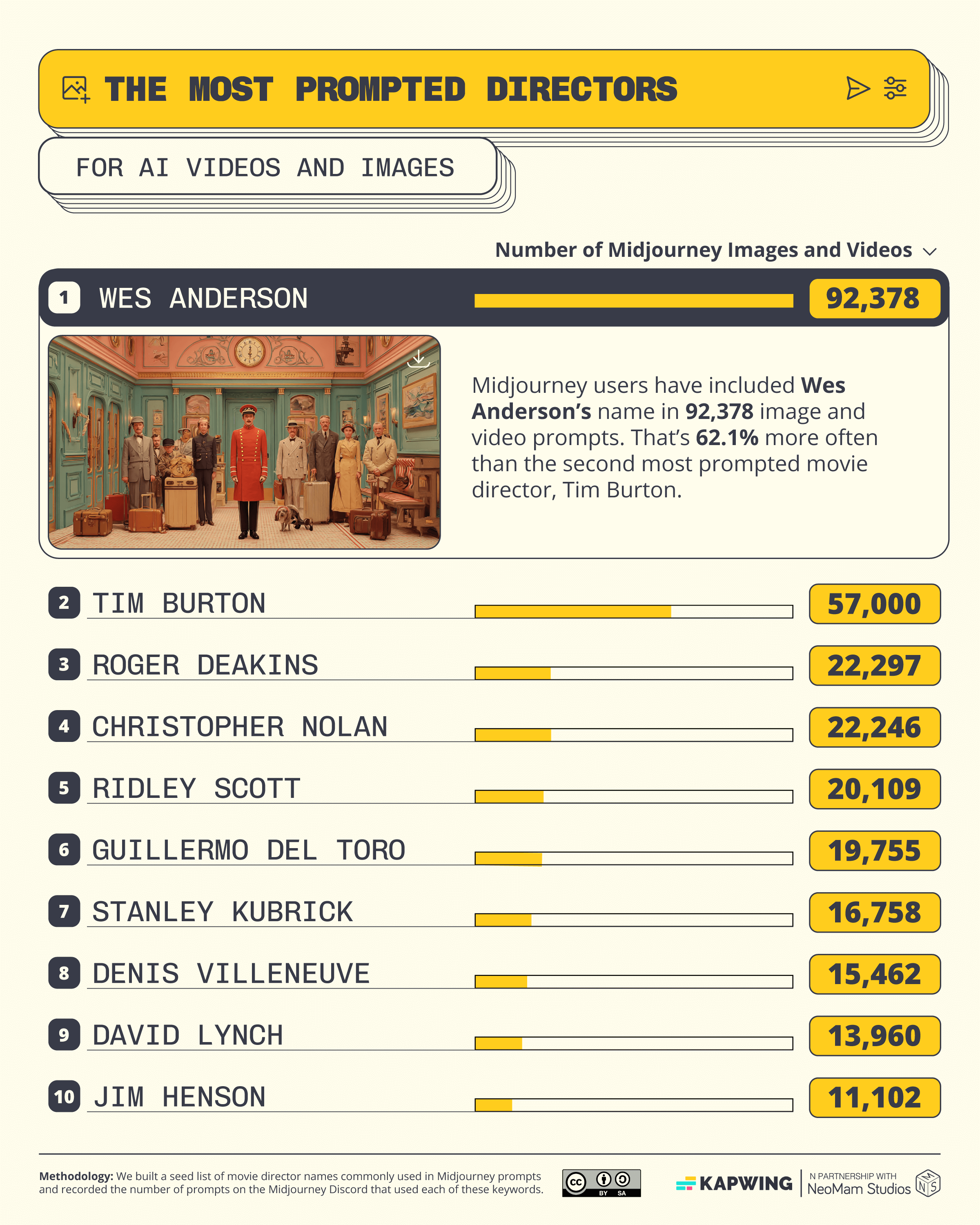
“I am not a meme,” says Wes Anderson in response to the popularity of aping his style, using generative AI or not. And he is quick to distinguish between the surface understanding of an artist’s ‘style’ and the fact that an artist’s work remains visually consistent due to the underlying thought and process behind the imagery.
“What people think of as my style is really my methods of, I think, how I can communicate information quickly,” he told Inverse. Indiewire quotes another concern: “I don’t want to see too much of someone else thinking about what I try to be because, God knows, I could then start doing it.”
Anderson’s aesthetic has appeared in 92,378 Midjourney prompts — more than Christopher Nolan (22,246), Ridley Scott (20,109), Guillermo del Toro (19,755) and Stanley Kubrick (16,758) combined.
Zaha Hadid More Prompted Than Gehry and Lloyd Wright

Some architects see the potential for generative AI to aid in the ideation and rendering stages of architectural design. As of March 2025, only 8% of U.S. architecture firms use AI at some point in their process — but another 20% admit they’re dipping their toes in the water. The leader of one large agency says they use it “to move from conceptual massings to character sketches of possible options.” Others, however, are concerned that generative AI in architecture compromises integrity, health and safety, and originality.
The most commonly invoked architect in generative AI image and video prompts is the Iraqi-British architect Zaha Hadid. Hadid’s name has been used 63,103 times, which is more than the next five architects — including Frank Gehry and Frank Lloyd Wright — put together.
But curiously, some of those prompts may have been made by the late architect’s own agency, Zaha Hadid Architects (ZHA). The agency’s principal, Patrik Schumacher, admits to encouraging his team to use Midjourney and DALL-E prompts in ideation.
“Nearly all of them have ‘Zaha Hadid’ in the prompting with various sorts of attributes and programmatic suggestions, etcetera,” Schumacher told a DigitalFUTURES roundtable. “Any of what comes out of this, I claim authorship for it in terms of validating, selecting, elaborating. So I feel very kind of empowered by all this possibility.”
New York is the Capital of AI-Generated Cities
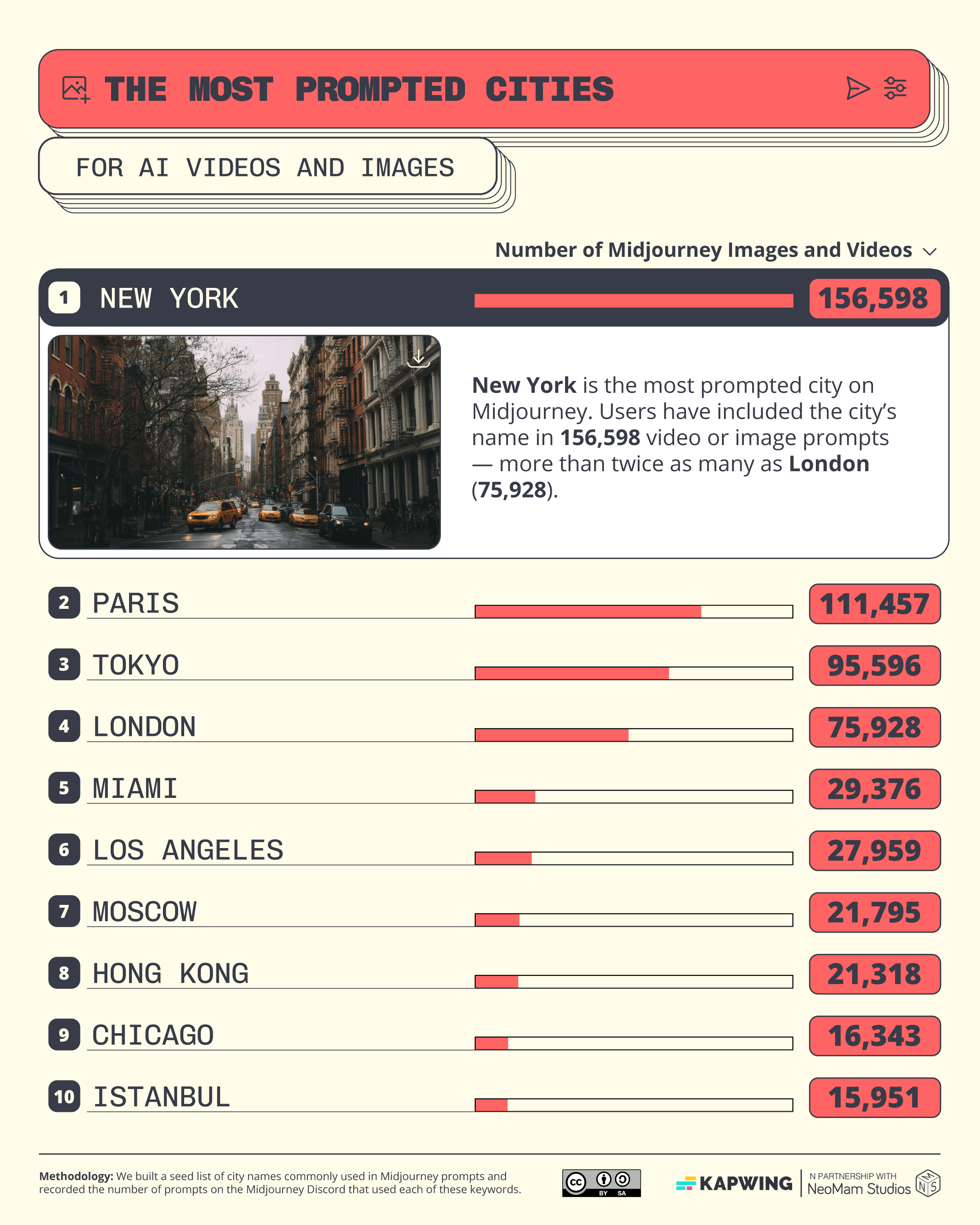
AI users may prompt with real city names to create imaginary images of their city of interest or to adjust another prompt to be — for example — “more New York.”
And it is New York City that gets prompted the most — some 156,598 times, or 1.4 times as often as second-placed Paris. This result may be due to New York’s self-perpetuating position as the archetypal city, which is reinforced by its frequent depiction in movies, which in turn diversifies the city’s profile (as a city of crime, of romance, of politics, of everyday stories, of elite enclaves, etc.).
Ironically, the image of New York City — or any other common prompt — may become contaminated through its own overuse in generative AI. As AI-generated images of New York proliferate and are in turn used to train the imaging models, it could lead to homogenization and “model collapse,” with subsequent generations referring only to themselves.
Star Wars Plagiarism Ushers In New Era of Artist-Engineer Collaboration
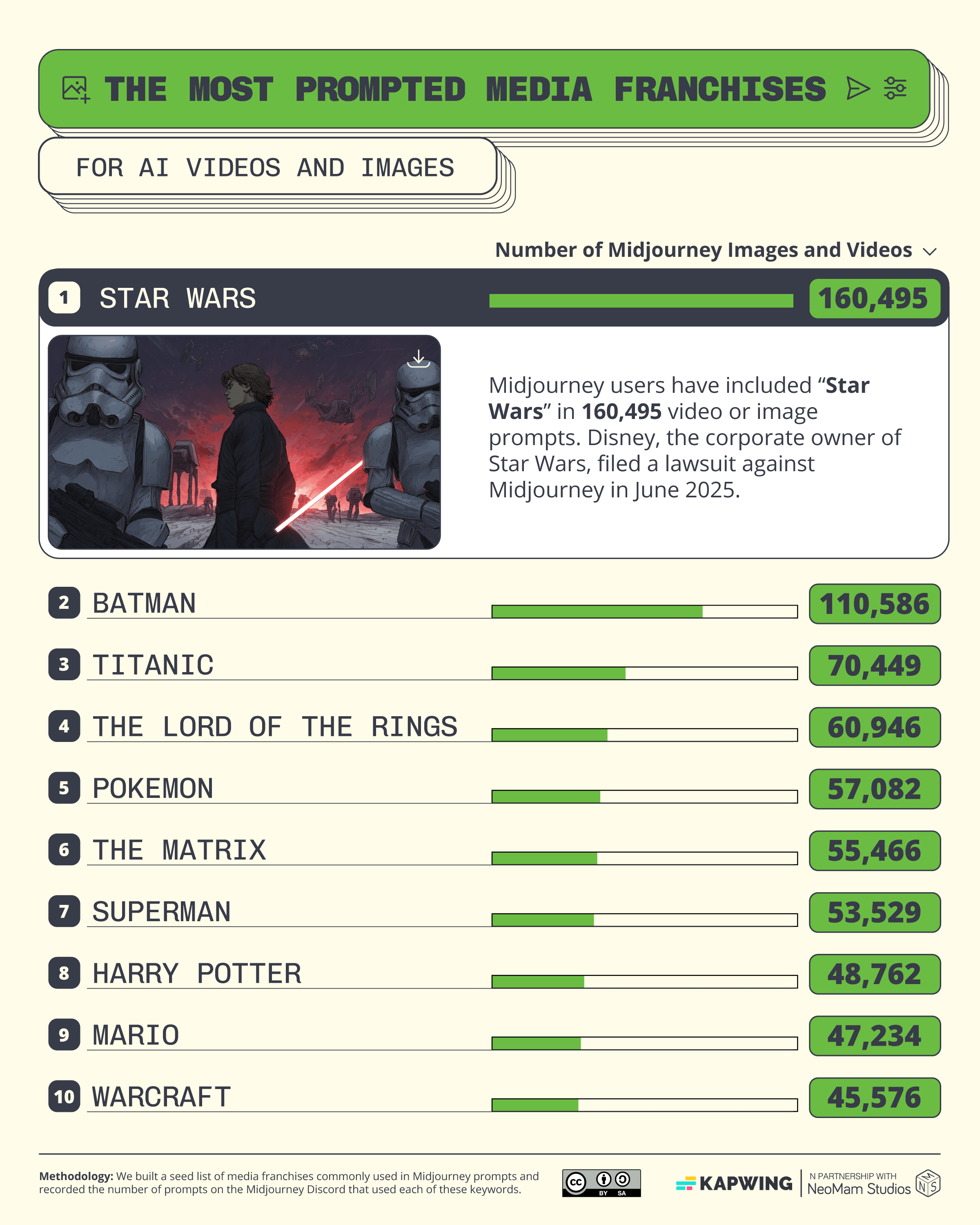
When Lucasfilm visual effects artist Rob Bredow took the TED stage in May 2025, he drew parallels between George Lucas putting “artists side by side with engineers” and today’s experiments with generative video.
At the same time, Star Wars’ present franchise owner, Disney, is suing Midjourney over what the entertainment company calls a “bottomless pit of plagiarism.” Indeed, we found that Star Wars is the most-prompted franchise, with 160,495 uses on Midjourney.
Disney (through chief legal officer Horacio Gutierrez) has been keen to differentiate between its accusations of “piracy” through the non-transformative re-use of its copyrighted characters, and the “responsible” use of generative AI “as a tool to further human creativity.”
“What happens when you put the latest AI tools in the hands of talented artists, both to see how good these tools are these days, and what does it do to our artists' imagination?” asked Bredow during his TED talk — inadvertently flagging the risk of the creative mind atrophying through overreliance on AI tools.
Akira and Ghibli Among Most-Popular Anime Prompts
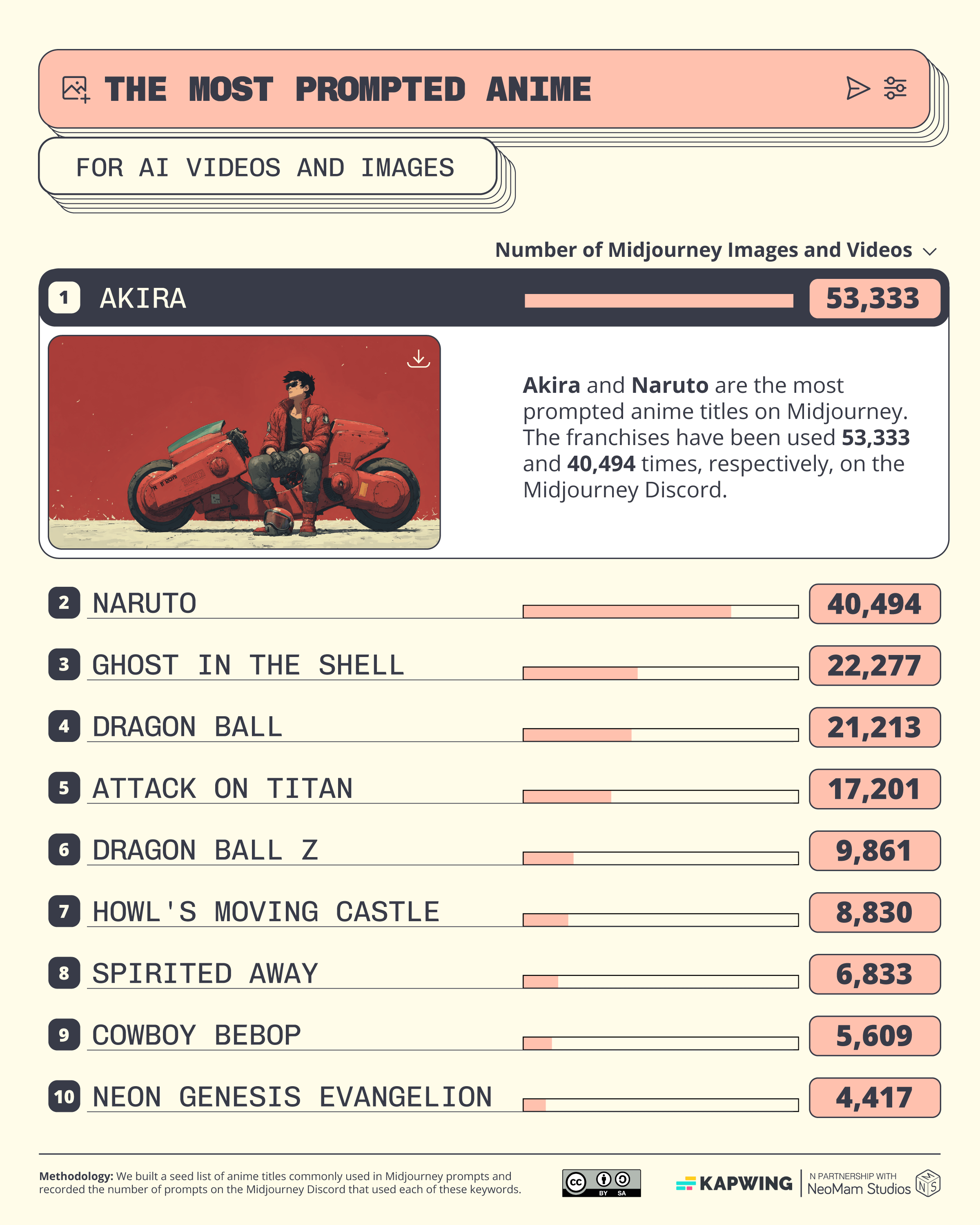
Anime, including Studio Ghibli’s work, has long been the subject of passionate fan art. Howl's Moving Castle (8,830 prompts) and Spirited Away (6,833) from Studio Ghibli are among the most-used anime prompts on Midjourney, while manga adaptations Akira (53,333) and Naruto (40,494) are top of the table.
“The Studio Ghibli AI Filter Is an Insult to Anime, Art, & Life,” read one fan culture publication headline as Ghibli-style generated images — mostly from Midjourney rival ChatGPT — became ubiquitous online in the spring of 2025. “Nothing about Studio Ghibli storytelling is random or repetitive,” continues the author, Vera Vargas. “Princess Mononoke isn't just memorable and beloved because of its art style… AI cannot and does not think or create for itself. It's only capable of taking art… then remixing it into a pastiche of spliced imagery based on the request of the AI's user.”
While touching on ethical and environmental objections to why Ghibli specifically should be left untouched by AI, Vargas also echoes the arguments raised against generated Wes Anderson art: the AI images only reference superficial patterns in the work. They neither draw from nor convey the deeper underlying techniques and themes of the artists.
Counterpoint: the Ghiblification craze felt like a “heartfelt celebration of the studio’s work,” says one Ghibli fan and AI dev. And the tool gave a generation of would-be fan artists the chance to engage with Ghibli’s work and create their own, illustrated narratives, regardless of talent.
McDonald’s Is the Most Commonly Generated Fast-Food Brand

Among those who jumped on the Ghiblification bandwagon in March was McDonald’s Mexico, which shared Ghibli-style images of characters eating McDonald’s food on social media. The backlash was swift, and McDonald’s has removed the images.
But McDonald’s itself has also been invoked in 18,318 Midjourney image and video prompts. This is nearly twice as many as Starbucks (9,616) and almost five times as many as third-placed KFC (3,764).
Still, the fast-food giant did not get much sympathy for the backlash. “What happened McDonald's? isn't it enough to pay a real artist?” asks one user, as quoted by Creative Bloq, with another asking, “one thing is one person uses it but a multi billion dollar company?”
A Drop of Originality
Legal cases and the public debate on generative AI remain unresolved. Now, the big AI firms have taken steps to cover their backs, variously by limiting their models or shifting the ethical responsibility to their users.
OpenAI’s DALL-E 3 image generator is “designed to decline requests that ask for an image in the style of a living artist” and also turns down requests for images of public figures — though it’s unclear whose work may have been used for training data. Meanwhile, Midjourney has removed its encouragement to “try invoking unique artists to get a unique style” in response to the class-action lawsuit being filed against them.
Still, from AI-generated images of world leaders to Trump’s likely AI-generated Apocalypse Now-style declaration of war on Chicago, famous names, brands and styles continue to make headline news even as they poke at the fabric of reality as we experience it.
In an attention economy, it sometimes feels like the only way through is by piggybacking on a successful trend or creating shocking images. Yet, there are truly original artists who are making a name for themselves by subverting the potential of generative AI and/or developing new aesthetics that themselves provoke wonder and inspiration among their followers.
Once the initial shock of generative AI’s ability to photorealistically depict people and places or to replicate styles has passed, it may be those who go beyond established aesthetics that inspire the next generation to think, “I wish I could do that!”
Methodology & Sources
We built a seed list of keywords across eight different categories of prompt style and subject:
- Artists
- Illustrators
- Directors
- Architects
- Cities
- Media franchises
- Fast-food chains
- Anime
We used the Midlibrary database for the artists, illustrators, directors, and architects, and built seed lists (of 100+ entries) of the most notable examples in the remaining categories. Then, we recorded the number of AI video and image prompts containing these keywords (e.g., "Wes Anderson") on the Midjourney Discord. In all, we analyzed a total of 897 keywords that appeared in 4,929,594 prompts.
Data is correct as of August 2025.






